Toowoomba's compassion shows with Eagles Nest Camp heritage listing

Toowoomba’s compassion for Great Depression-era unemployed has been further emphasised by the State heritage-listing of the Eagles Nest Camp in Redwood Park.
The story of Eagles Nest Camp is the story of the terrible hardships that befell the population during the Great Depression of the 1930s – and of Toowoomba’s benevolence that made national headlines.
“Eagles Nest Camp is a 2.65-hectare site within Redwood Park, on the eastern side of the Great Dividing Range at Toowoomba,” Queensland Heritage Council Chair Debbie Best said.
“Redwood Park was a native bird sanctuary from 1911, appreciated by residents and visitors alike, and in the 1930s a small portion of the park became a makeshift camp for unemployed itinerant men impacted by the Great Depression.
“Called Eagles Nest Camp, it was set up by prominent Toowoomba resident and philanthropist Dr Thomas Price (1871–1957), as well as other concerned residents, to alleviate the hardships experienced by these men.
“The camp soon became known across Australia as one of the best of its type, with many newspaper features touting its merit and the respectability of its occupants.”
Ms Best said that it was now hard to imagine what the Australian population endured during the Great Depression.
“Unemployment spiralled and while the state government of the time provided emergency rations, it also said unemployed men could not receive these rations from the same place in successive weeks.
“This meant men wandered from town to town to find work and receive rations.
“They were known as the ‘deserving poor’ who wanted to work, but no work was available, and they comprised the whole cross-section of society from returned war heroes to university academics.”
With materials, tools and other supplies given by Dr Price and supporters, Eagles Nest Camp was constructed by camp residents and ran on a model of self-sufficiency.
The camp included sleeping huts (built from flattened kerosine tins and cornsacks), a dining shed, galley, showers, a meat safe, a fresh water supply, and a large vegetable garden and stockyards, and it could accommodate up to 35 men at a time.
In 1930, some 1920 itinerant “travellers” were receiving rations in Toowoomba, which soon became known to these men as a “good town” in reference to the services available to them.
It was estimated that by 1935 more than 1500 men had stayed at the camp.
“It is not clear when the Eagles Nest Camp was vacated and the structures removed, however, it is likely that it coincided with the beginning of World War II,” Ms Best said.
Very little evidence of the Eagles Nest Camp was visible in the intervening years, but in 1994 an archaeological investigation was carried out by the University of Southern Queensland, funded by the then Toowoomba City Council.
The foundations of 19 structures were identified, along with numerous paths and stone-edged garden beds, as well as the location of the vegetable gardens and stockyards.
The mess hall and kitchen platforms were excavated to reveal their layout, and a dump site along the creek produced a range of glass, ceramic, metal artefacts and crockery.
“Unemployed men’s camps were common in the Great Depression with many in Brisbane and others in Townsville, Charters Towers, Cairns, Gympie and Warwick,” Ms Best said.
“However, most consisted of shacks, humpies and lean-tos and no evidence of their existence remains.
“Eagles Nest Camp on the other hand is unique as it is now the only known example of a Great Depression-era unemployed itinerant men’s camp in Queensland with surviving features.
“The camp gives us a greater understanding of these camps, their occupants and their activities and infrastructure,” Ms Best said.
The application to heritage list the Eagles Nest Camp was submitted by a member of the Toowoomba community, with the Queensland Heritage Council entering the place into the Queensland Heritage Register on 26 March 2021.
See more information on the Eagles Nest Camp, Redwood Park.
